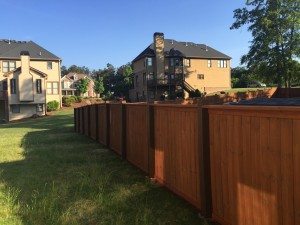Spring is the perfect time to stain and seal outdoor wood, especially decks and fences. Even if the wood was stained and sealed when the fencing was installed and the decking erected, the elements inevitably take their toll, with the harsh rays of the sun drying it out and rain and wind weathering it in a damaging way.
Key Reasons to Stain and Seal your Outdoor Wood
Apart from decay-resistant redwood and cedar, most less-expensive softwoods commonly used for construction (like pine) are pressure treated with preservatives in the factory to help prevent insect infestation and rot. But in addition to preservatives, good quality wood stains and water-repellant sealers are designed to make wood look good and last for a very long time. Stains generally add to or enhance the color of timber, while sealants make it weatherproof, protecting it from moisture, at the same time helping to prevent it from splitting and cracking. Stains (which essentially dye or color lumber) may be used to improve the visual appeal of fences and decks, and to hide imperfections, including knots. Although not as common, some stains do the opposite, and may be used to emphasize contrasts like growth rings in wood.
Stains (which essentially dye or color lumber) may be used to improve the visual appeal of fences and decks, and to hide imperfections, including knots. Although not as common, some stains do the opposite, and may be used to emphasize contrasts like growth rings in wood.
Even though the function of sealers is different to stains, they may be used in the same way as stains, to either enhance grain and other features, or when they contain pigment, to hide them.
How to Choose Fence and Deck Stains and Sealants
There are many different types and brands of fence and deck stains and sealers, including wood dressing, traditional polyurethane varnish, and contemporary products that soak into the wood, feeding and protecting it.
Stains are generally either a solid color, or semi-transparent. Those that produce a solid color cover the natural wood grain typically mimicking the colors of different types of wood including Oregon pine, mahogany, oak, teak and beech. Semi-transparent stains contain sufficient pigment to tint the surface of the wood without hiding the grain. There are water-based as well as oil-based versions, some of which are recommended for reviving the original color of the wood, or for “dressing up” pressure-treated lumber.
Water-repellant sealers are also manufactured in oil- and water-based forms, some of which will color the wood as well as seal it, depending whether or not they are tinted. Other types will just darken the natural or stained color of the wood slightly. Many formulations are made to block the harmful UV rays of the sun as well as prevent mildew, in which case they contain mildeweides.
Ultimately, regularly staining and/or sealing your wooden deck and fencing will help to protect your investment and keep it looking good.
Using a McDonough Fence Contractor to Stain and Seal Your Outdoor Wood
If you’re not in the DIY market, a reliable McDonough fence contractor can do the job for you. Natural Enclosures Fence Company specializes in fence and deck installations, and uses Wood Defender fence and deck staining and sealing products exclusively. These products, manufactured by Standard Paints Inc., penetrate and seal the wood, waterproofing it and making it both UV and mildew resistant. They also stabilize the color of the wood, and when used on weathered wood, will restore and protect it.
Call our friendly professionals today to find out more about how you can protect or revive all your outdoor wood.
